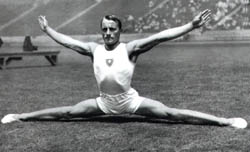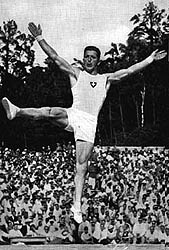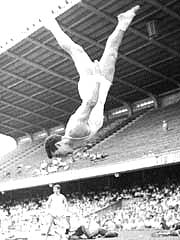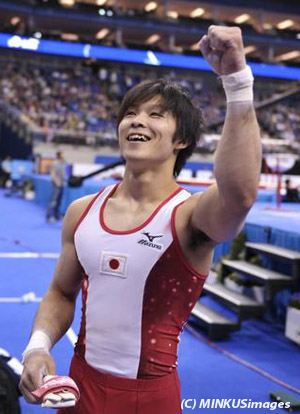 |
History
of FLOOR EXERCISES
The floor exercise
developed out of the free exercise with our without hand apparatus
which was a fixture at competitions for a long time. A 1923
'Memorandum' which made suggestions for (world championships)
tournaments regulations called for the acceptance of the free
exercises as being equal to the exercises on the apparatus for the
first time in history. |
|
|
Yet an individual
artistic floor exercise -both compulsory and optional- would not
be included in competitions until the 1930 World Championships
in Luxembourg, where it replaced the mass demonstrations.
|

German
|
|
|
|
|
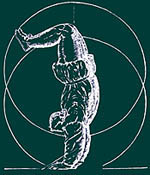
Pic. from Tuccaro book
about
"Arial Jumps" |
Archange
Tuccaro (1536 - 1616)
The
Italian acrobat at the French royal court wrote a 400 page book
about "Arial Jumps" which was published in Paris in
1599. The book is richly illustrated and describes acrobatic
routines on the floor and the apparatus. Tuccaro also instructed
king Henry III in floor exercise and was awarded the title of
"Court Jumper" (Saltarin)
.
In a way
Tuccaro is the father of the methodology of gymnastics with
this book. Today, acrobatic elements are a major part of a floor
routine.
But exercises on the floor
are as old as the circus and jesters. Traces can even be found
in the cave paintings of Beni Hasan that date back to pre-Christian times.. |
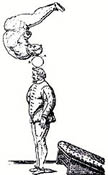 |
. |
Modern
gymnastics as an individual discipline goes back to the free
exercises developed in Germany
by Adolf Spiess (1810 - 1858) and Justus Carl Lion (1829 - 1901)
although these didn't include Tuccaro's acrobatic elements.
(F.L.Jahn who was completely opposed to the use of foreign words
in German referred to them as 'Kopfuebern' (= head over heals') |

The mass
or group routines with rigid collective patterns of movement were used
for a long time.
At
the German Gym Festival in Munich in 1923 Martin Gebhardt (who represented
Frankfurt despite originally being from Leipzig) was the first gymnast
who dared to perform a flip flop. Even 10 years later, there still was
no apparatus floor. Gymnasts performed their free exercises on the
lawn.
| . |
Luxembourg
1930 saw the first official apparatus
rankings. Yugoslav Josip Primozic (right) went down in history as the first world champion on
floor exercise. Floor exercises continued to be done on grass
even at the 1932 Los Angeles Olympics. Switzerland dominated
the world scene in the thirties, not only on floor. 1934 world
champion Georg Miez, who
placed second in 1930, took the gold on floor in 1936 ahead
of his compatriots Josef Walther and Eugen Mack.
Floor
exercise went through some substantial changes in the thirties
and the floor at the 1936 Olympics in Berlin was already lightly
sprung. Descriptions of dynamic floor routines had existed since
the late twenties
|
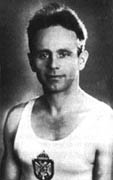
Joze Primozic (YUG)
|
Hungarian Ferenc Pataki's dynamic acrobatics
mark the beginning of a new era of floor routines in 1937- the Hungarian
also took the Olympic title on floor.
|
|
|
|
The
English and Germans pioneered special floor exercise mats ('sprung floors')
as early as the twenties as well as the Danes in the thirties where the
great Niels Bukh had some astonishing results.
(Eckhard Herholz)
(Translation:
N. Schuler)
|
* Sources/Quellen:
"Der Vorturner", 1927/28; "Das Turnjahrhundert
der Deutschen", Götze/Herholz: Beckmanns Sportlexikon A-Z,
Leipzig, Wien 1933; "Deutsche Turnzeitung", 1901;
"Neue deutsche Turnzeitung", 1961, J. Leirich; "Geschichte
der Turngeräte", J. Göhler/R. Spieth; "Mondsalto",
gymbooks Verlag 1994, A. Götze/J. Uhr; "FlickFlack...",
Sportverlag Berlin, A .Götze/H.-J. Zeume; "The History
of British Gymnastics", 1988 by BAGA.
* Rememberring:
|
|
|
|
|









